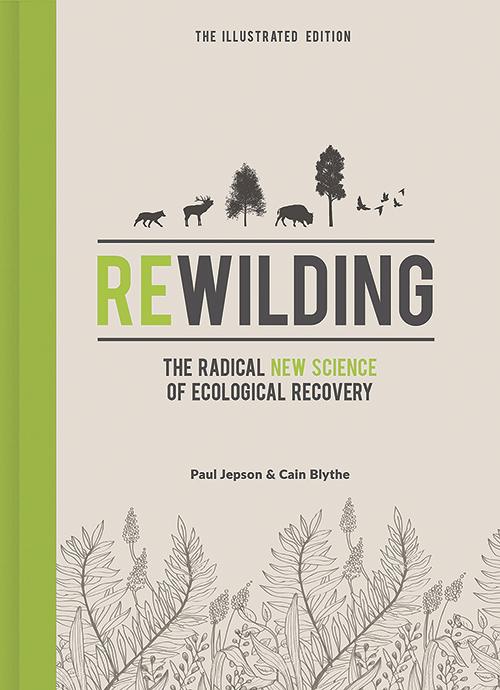
Rewilding: The Radical New Science of Ecological Recovery (The Illustrated Edition)
Reviewed by Ruah Swennerfelt
November 1, 2022
By Paul Jepson and Cain Blythe. The MIT Press, 2022. 224 pages. $29.95/hardcover.
As I was preparing this review, my attention was drawn to an article in the New York Times. It was about a man who had taken charge of his father’s ranch in northeastern Nevada and who had changed his attitude about the beavers that were abundant on the land. His father had blasted their dams on a regular basis, but the son decided to partner with the beavers. Last year, during an extreme drought, his cattle had plenty of water in the beaver pools. And when a huge rain might have flooded the land, the beaver dams slowed the water and allowed the water to sink in. This is a beautiful example of being in partnership with nature: a current, real-life example of rewilding.
Originally published in 2020 by London-based Icon Books, Rewilding is now available to U.S. readers as a hardcover, illustrated edition from the MIT Press in Cambridge, Mass. As a caution, let me say that the book is a science book for non-scientists, but I did have to look up some words to fully understand what I was reading. That caution aside, this is a wonderful, hopeful book about a cutting-edge science of caring for the land and its inhabitants. The authors explain that conventional North American conservation works toward recreating a baseline from the time of European contact (ca 1492), while in Europe, the baseline is set for the mid-nineteenth century, before the impact of industrialization. The current goal is to reconstruct the natural world to reflect those relatively recent times.
The rewilding science, however, sets its baseline at about 11,700 years ago, the approximate time of human settlement in North America. With new possibilities of DNA research on ancient finds, we can learn what flora and fauna lived here before human settlement and how and where they lived. The authors explain:
[Rewilding] is the new understanding of ecological processes emerging from the interplay between herbivore grazing and vegetation structure and natural disturbance that represents the core contribution of rewilding science to the broader disciplines of ecological restoration and conservation science.
Although rewilding science is new, there are already examples of some successes, such as the reintroduction of wolves to Yellowstone National Park, where surprising, positive changes have occurred throughout the ecology of the park since the wolves have settled in. Over 30 years ago, the Netherlands reintroduced a mix of wild deer species and “wilded” breeds of ponies and cattle. Birds and small mammals rebounded, but there were concerns that leaving the cattle and ponies to starve in harsh winters would be cruel. This led to understanding that while domesticated animals are protected from cruel treatment, rewilded animals are meant to be wild, and wild animals die regularly in nature. This is one of the many challenges for the new science. The reintroduction of wolves in Yellowstone met some fierce opposition, but the results surprised and pleased most.
And not only does nature rebound when relieved of the human footprint, but rewilded land systems have the potential to sequester more carbon in their soils, in woodland groves, and in the expanded animal fauna. This means that it can help turn back the advancement of the climate crisis.
In the introduction, the authors share their delight with the publisher’s suggestion of an illustrated version. They wrote: “As the old adage goes, ‘a picture is worth a thousand words,’” and I agree. The color photographs of exciting animals, such as Konik horses, Tauros (cattle-like animals), and Aldabra giant tortoises (chosen for their similarity to animals that roamed the land thousands of years ago) bring the narrative to life. And the excellent infographics helped me envision what the outcome might be in a successful rewilding project. These newly added visuals frequently encouraged me to stop to ponder and understand this radical new way of ecological recovery.
Why might you want to read a book about the reintroduction of mega-herbivores, carnivores, and grazers to various landscapes? I have come to believe that this rewilding approach to respecting natural systems and the desire to co-create and partner with the land and all its inhabitants reflects Friends’ new understanding that there is that of God in all Creation. Reading this book gives the reader a chance to advocate and support this new science, and consider how humans might go forth in this troubled world, including caring for Earth in our everyday work, play, and worship.
Ruah Swennerfelt is a member of Middlebury (Vt.) Meeting, where she serves on the Earthcare Committee. She and her husband, Louis Cox, are homesteaders on unceded lands of the Abenaki nation. They raise most of the vegetables and fruits that they eat, feeling rooted to place and living rich and fulfilling lives.



Comments on Friendsjournal.org may be used in the Forum of the print magazine and may be edited for length and clarity.